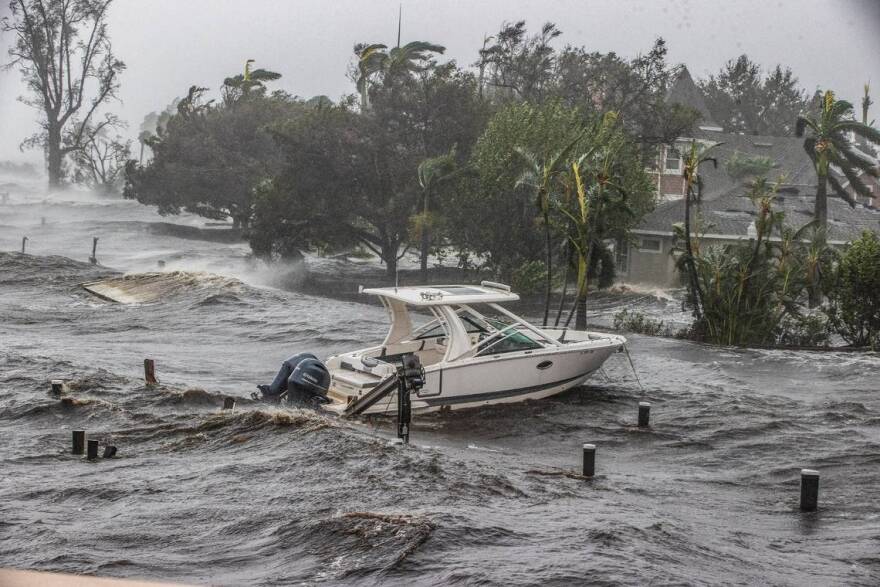NEW YORK — A growing number of Americans are finding it difficult to afford insurance on their homes, a problem only expected to worsen because insurers and lawmakers have underestimated the impact of climate change, a new report says.
A report from First Street Foundation released Wednesday says states such as California, Florida and Louisiana, which are prone to wildfires and damaging storms and flooding, are likely to see the most dramatic increases in premiums. But the fire that destroyed the Hawaiian community of Lahaina on Aug. 8, as well as the historic flooding that happened in Vermont and Maine in July, are examples of events that could drive up insurance costs for homeowners in other states.
First Street estimates, factoring climate models into the financial risk of properties in its report, that roughly 39 million properties — roughly a quarter of all homes in the country — are being underpriced for the climate risk to insure those properties.
“Some places may be impacted very minimally, but other places could see massive increases in insurance premiums in the coming years,” said Jeremy Porter, head of climate implications at First Street and a co-author of the report.
First Street, a New York-based non-profit, has been a to-go researcher on the financial implications of climate change for years. Their research is used by Fannie Mae, Bank of America, the Treasury Department and others for understanding the potential risks to properties.
There are several signs that climate change is taking its toll on the insurance industry. The U.S. homeowner’s insurance industry has had three straight years of underwriting losses, according to credit rating agency AM Best. Losses for the first half of 2023 totaled $24.5 billion, which is roughly what was lost in all of 2022.
“(Climate change) is a problem that is already here,” said Todd Bevington, a managing director at the insurance broker VIU by HUB. In his 30 years of doing insurance, he said “I’ve never seen the market turn this quickly or significantly.”
Record numbers of Americans are now insured through state-affiliated “insurers of last resort” like California’s FAIR Plan, or Louisiana or Florida’s Citizens property insurance companies. These programs were designed to insure properties where private insurance companies have refused to insure or the price for private insurance is too expensive.
In Florida, Citizens Property Insurance Corp. now has 1.4 million homeowners’ policies in effect, nearly triple in five years. It added more than 4,600 policies last week alone.
Citizens had 1,391,777 policies as of last Friday, up from 1,387,163 a week earlier and 1,379,289 two weeks earlier, according to data posted on its website.
READ MORE: Got hurricane insurance from Citizens? Here’s a new reason your bill may rise in Florida
Citizens, which was created as an insurer of last resort, has seen massive growth during the past three years as private insurers have shed policies and raised rates because of financial problems. Citizens had 499,056 policies on Aug. 31, 2020; 687,079 policies on Aug. 31, 2021; and 1,026,829 policies on Aug. 31, 2022, according to its website.
“It’s a global problem. Virtually every geography is seeing a repricing of risk,” said Lara Mowery, global head of distribution at Guy Carpenter, in an interview.
Reinsurers step in to help cover losses resulting from a catastrophe, so regular insurance companies do not take on all of the risk. In one example of a typical reinsurance contract, a $20 million contract could require the insurance company to cover the first $10 million in claims and the reinsurer to pick up the other $10 million.
Mowery added that many reinsurance firms now have resources dedicated to studying the impact of climate change on how to price catastrophes.
There have been other factors impacting the insurance industry as well. Inflation has made the cost of repairing homes pricier and home prices remain near record levels. A labor shortage means getting damaged homes repaired may take longer, requiring insurers to pay for temporary housing for policyholders longer.
In short, an industry whose business model is calculating risk based on what happened in the past is increasingly unable to do so.
“You can no longer rely on 100 years of wildfire data to price risk when the unprecedented has happened,” Mowery said.
Going forward, it may become more necessary for potential homebuyers to look at the cost of insuring the property they are looking at before locking in a mortgage rate, due to the potential for significant rate hikes in the future.
“It used to be homeowner's insurance was an afterthought when you are looking at buying a property. Now you'll really need to do your research into what risks there may be in that property in the coming years,” said VIU by Hub’s Bevington.
The News Service of Florida contributed to this story.





